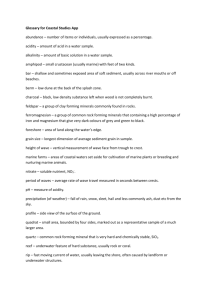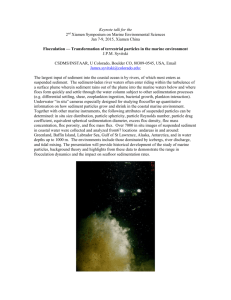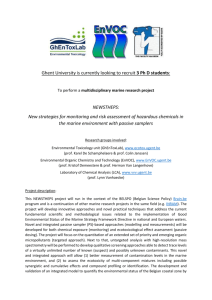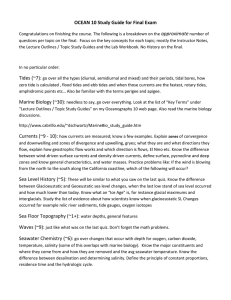32 presentation 2003-2004 llfresis
advertisement
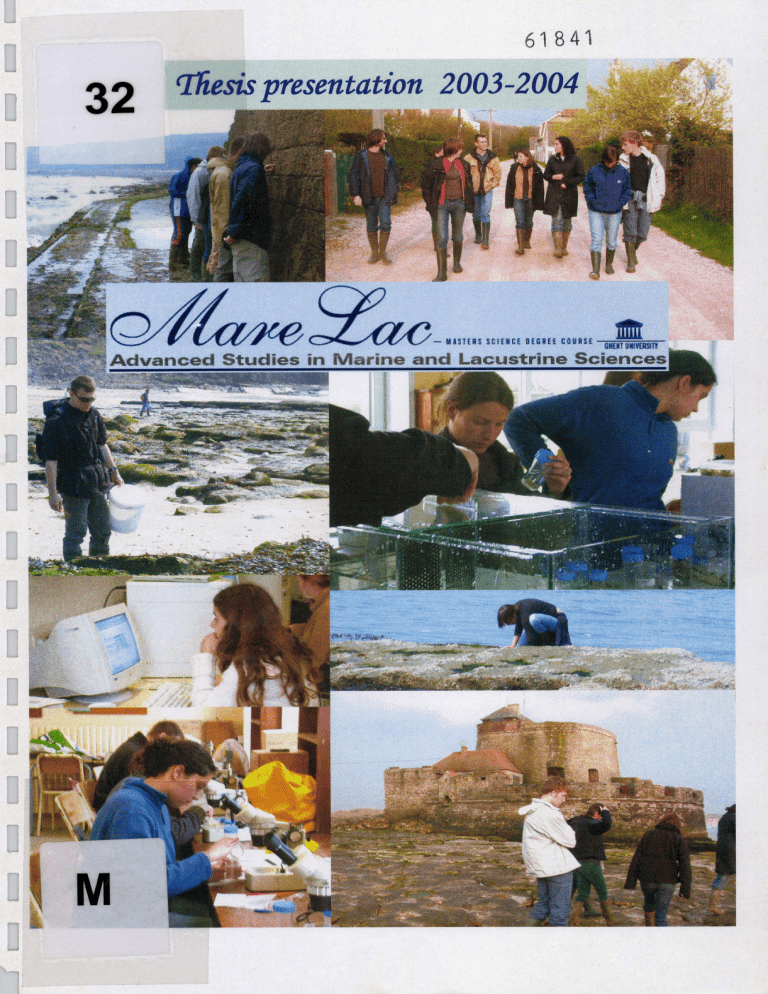
51841
32
llfresis presentation 2003-2004
J\dvnnced Studi+s in Merine and Lacustrine Sciencee
rEI
."+rw€l
Thesis defense Marelac Monday 28tt' June 2A04
Room Valdre Billiet (G wing - ground floor) 58
Sterrecampus - Krijgslaan 281
Student
Time
Title
Promoter
Eram
Exam commission
commission
8.30 am
Frederic Vandepene
Do bigger fish arrive and spawn at the
spawning grounds before smaller fi sh :
beach spawning capelin (Mal/otus
vil/osus) from coastal Nevufoundland.
A. Vanreusel
Jan Mees (VLIZ)
David Methven
(St John, Canada)
8.55 am
Jeroen Ingels
FreeJiving nematodes at both sides of the
Scotia Arc, with special attention to the
biodiversity of the genera Desmodora and
Desmodorella (Fam. Desmodoridae).
S. Vanhove
A. Vanreusel
Rudy Herman (AWl)
9. 20 am
Wouter Willems
A G|S-approach to assess the impact of
two pulpmills (Woodfibre and Port
Mellon) on intertidalbiodiversity in the
Howe Sound Region (British Columbia,
A. Vanreusel
S. Degraer
Shannon Bard
(Dalhousie, Canada)
9.45 am
Fien De
Raedemaecker
A GIS-approach to compare intertidal
diversity and contaminant loading in the
A. Vanreusel
S. Degraer
Shannon Bard
The cost of transport of Sepra apama on
the Whvalla breedino orounds.
A. Vanreusel
M. Vincx
Canada).
marine receiving environment of two pulp
mills in British Columbia, Canada,
10,10 am
Koen Reyntjens
Ron
0'Dor
{Dalhorrsie Canada\
;1035am
Coffee B'rbak
11.00 am
lsabelle Dufour
Physical characterization of the Sierra
Ventana region in view of the rehabilitation
of a dumping site of dredged material into
a potential area for marine aggregates
extraction.
V. Van Lancker
S. Deleu
Michael Fettweis
(MUMM)
lne Danas
A comparative analysis and validation of
seafl oor classification techniques.
V. Van Lancker
Geert
Moerkerke
(Maoelas)
Marc Roche (Fund for
Sand extraction)
11.50 am
Fabiane Gallucci
Can field distributions of estuarine
intertidal nemalodes be explained by
sediment constraints on foraging
success? The case of the predacious
E n o n I o i d e s /onoLsohr-r/o.srr.q.
T. Moens
M. Vincx
Carlo Heip (NIOO,ND
P,EF-"rirr
$irchb&-ak
2pm
Ainhoa Blanco
Pilot study for the rearing of the blue
mussel (Mytrlus edufs) larvae in the
laboratorv.
M. Vincx
A. Verween
Marco Dubbeldam
(Aquasense, Nl)
2.25pn
Leen Vandepitte
Spatial and temporal variability of the epi-,
hyper- and endobenthos of nine sandy
beaches alono the Ecuadorian coast.
M. Vincx
S, Degraer
Jan Weslawski
(PAS, Poland)
2.50 pm
Hannelore Maelfait
The effect of dense oatches of lubebuilders on the macrofaunal communitv.
S. Degraer
M. Vincx
Andre Catrijsse (VLIZ)
3.15 prn
Marijn Rabaut
System Analysis for Decision Support in
the Allocation of Marine Protected Areas
in the Beloian Part of the North Sea.
M, Vincx
J. Schrijvers
S. Degraer
11.25
an
be94t
Do bigger fish arrive and spawn at the spawning grounds before smaller fish:
beach spawning capelin (Mallotus villosus) from coastal Newfoundland.
Frederic Vandeperre
David Methven (St John University New Brunswick Canada)
Ann vanreusel (Marine Biology uGent, coordinator BroDAeuA EU-canada)
ABSTRACT
-
A relationship between body size and time of spawning has often
been
described for both pelagic and non-pelagic fish species that migrate for the purpose of
spawning. The present study investigates this relationship for capelin, a pelagic smelt-like
species that spawns on the beaches of Newfoundland. Simple linear regressions were
carried out separately for three groups, ovid females, spent females and males, and for 3
successive years (1982-1984). Bigger fish arrived near the spawning grounds first, for all
three groups and all three years and was most obvious for female capelin. Analyses of
stomach contents of Atlantic cod (Gadus morhua), an important predator of capelin,
showed a similar decrease in mean size of capelin throughout the capelin spawning
season. Fufthermore, t-tests strongly suggest that early in the spawning seasons, when
capelin abundance was high, cod selected for bigger capelin, whereas towards the end of
the spawning seasons, when capelin abundance was low, cod did not show any size
preference.
Frederic@vandeperre.ws
Free-living nematodes at both sides of the Scotia Arc, with special attention to
the biodiversity of the genera Desmodora and Desmodorella (family
Desmodoridae).
Jeroen Ingels
61
B
42
Ann Vanreusel, Sandra Vanhove (Marine Biology UGent, coordinator BIODAQUA EU-Canada)
ABSTMCT - During the I-AMPOS campaign (2002) on board of the RV "Polarstern"
samples were taken along the Scotia Arc. In this study samples of two stations from the
nofthern and southern paft of the Scotia Arc (at a depths of 277 and 307 m) were
analysed for meiofauna (especially nematodes). By identification of all species within two
closely related subdominant nematode genera (Desmodora & Desmodorella) in the two
Scotia Arc samples and available samples from adjacent areas (Maggellan Region, Drake
Passage, Weddell Sea) it is concluded that: 1) Estimations of diversity are sample-size
dependent and ask for standard sampling and processing methodology;2) The Scotia Arc
can be seen as a shallow bridge and a possible exchange route for meiofauna between the
Antarctic and South America; 3) Nematode species are constraint by environmental
conditions (bathymetry, sediment characteristics) rather than by geographical barriers; 4)
Local nematode diversity does not necessarily reflect regional nematode diversity (i.e.
restrictions in nematode species distributions result in high species turn-over between
different stations, not always usable to predict larger scale diversity).
jeroen i ngels@hotmai l.com
61843
two pulp mills (Woodfibre and Poft
Mellon) on inteftidal biodiversity in the Howe Sound region (British Columbia,
A GlS-approach to assess the impact of
Canada).
Wouter Willems
Shannnon Bard (Dalhousie Univercity, Halifax, Canada)
Ann Vanreusel (Marine Biology UGent coordinator BIODAQUA EU-Canada)
-
ABSTMCT
Inteftidal biodiversity data collected by Bard (1998) in 1990-1993 at nine
sites in Howe Sound, a British Columbian fiord, were the source data for this paper. Two
pulp mills located in Woodfibre and Poft Mellon, discharge their effiuent in this fiord.
Several process changes took place in both mills just before and during the intertidal
sampling. The goal of this paper is to assess the impact of mill effluent on intertidal biota,
by comparing trends in inteftidal biodiversity with known mill impact, derived from tracers:
dioxin/furan levels in the sediment and in crabs. Because intertidal and contaminant
sampling sites were differenf the use of traditional statistic tests was not possible.
Therefore, contaminant and inteftidal data were combined in a Geographical Information
System (GIS), which allowed to obserue correlations. Also included in this GIS were mill
effluent dispersion patterns, suface currents and sediment data, which allowed the
integrated interpretation of the data. Confounding factors in the interpretation of intertidal
data, including local oceanographic conditions and non-pulp mill pollution sources, are
identified in this paper. As such, this paper serues to help interpret and plan the sampling
scheduled for the summer of 2A04. The classification of animal species in feeding guilds
and algae in taxonomic aroups provided new insights in the data. The general trend at all
sites seems an increase in species diversity. Discoloration and even die-off in the vicinity
of the mills, was found to be correlated with sodium chlorate spills. As a conclusion,
inteftidal monitoring is a valuable addition to the current practice of taking grab samples
of the sediment, but on its own is not a representative tool for the deeper environment.
Keywords: pulp mill pollution, inteftidal biodiversity,
environmental monitoring
Woutenvi Ilems100@pi. be
GIt
Howe Sound,
51 845
to compare inteftidal diversity and contaminant loading in the
marine receiving environment of two pulp mills in British Columbia, Canada.
A GlS-approach
Fien De Raedemaecker
Shannnon Bard (Dalhousie Univercity, Halifax' Canada)
Ann Vanreusel (Marine Biology UGent, coordinator BIODAQUA EU-Canada)
ABSTMCT Intertidal monitoring during 1992 and 1993 at mid to low intertidal rockyshore beaches surrounding two marine-discharging pulp mills in British Columbia revealed
a decline of biodiversity as the sites were closer located near the mill outlet. The present
-
in
species richness, trophic composition and algal
composition of intertidal benthos over a gradient of effluent exposure. Those spatial
trends are related to dioxin/furan loads in sediment, Dungeness crab (cancer magistetl
hepatopancreas and Pacific oyster (Crassostrea gigas) muscle, sampled in the same area
but at' slightly different locations. Local oceanographic conditions and non-pulp mill
pollution sources in the vicinity of the two pulp mills are considered as confounding factors
in assessing pulp mill effluent. Statistical analyses were used to assess trends in intertidal
biodiversity. A GlS-approach, incorporating the most impoftant known oceanographic
features, is a very helpful additional tool to visualise the major relationships between
study reports spatial changes
intertidal biodiversity and contaminant loadings.
This study has discovered that in some regions cumulative contamination may exert a
large and long-lasting effect on intertidal diversity and community structure even when
cuirent pollution has decreased. Feeding guilds deemed very useful tools to reflect shifts
in the functioning of a given area. Deposit feeders were highly abundant on isolated
patches close to the mill with abundant sources of organic material. Green algae deemed
iolerant to pulp mill effiuent whereas red algae were the most sensitive to bleached kraft
pulp mill effluent. This study suggests that environmental impact is not always
proportional to the volume of pulp and paper production and waste loading but highly
depends on local oceanographic conditions and historic depositions.
There is a strong need for long-term monitoring to complete the accurate assessment or
potential sublethal and ecosystem effects, and to understand the bioaccumulation
dynamics of effluents on a site-specific basis. In the summer of 2004, inteftidal monitoring
will be repeated at the same sites, which aims to detect long-term changes in biodiversity
and to evaluate the impact of historic contaminated sediment deposits. This paper serues
as a preliminary study to propose a sampling regime and recommend appropriate analysis
for interpreting the results.
Keywords: marine pulp mills, inteftidal monitoring, TEQ, British Columbia' GIS
Fienderaedemaecker@ya hoo.com
61 8 4 6
The cost of locomotion of Sepia apama on the Whyalla mating grounds.
Koen R.A. Reyntjens
Ron O'Dor, Alison J. King (Dalhousie University, Halifax, Canada)
Ann Vanreusel (Marine Biology UGent, coordinator BIODAQUA EU-Canada)
ABSTMCT - The giant Australian cuttlefish, Sepia apama are like other cephalopods
uniquely suited for field energetic studies. Their hollow mantles that pump water for
respiration and jetting can also accommodate differential transducer-transmitters. These
transmitters indicate pressure-flow output, which can be calibrated against oxygen
consumption by swim-tunnel respirometry. Radio-acoustic positioning telemetry (RAPT)
recorded pressure-flow power and cuttlefish movement with a meter accuracy during their
annual spawning aggregation near Whyalla, South Australia. Combined with behavioural
video-rnaterial on these mating grounds speed-pressure flow relationships were
determined for both cuttlefish jetting and fin-undulation separately. The. cost for jetting
and finning was calculated and compared with the cost of transport of other cephalopods.
An activity spectrum was created and mating behaviour was investigated.
Keywords: cuttlefish, Sepia apama, RAPT, filter, finning, jetting, mating,
Whyalla
Dimmuroen@yahoo.com
61 8 47
f
Physical characterization of the Sierra Ventana region in view of the
rehabilitation of a dumping site of dredged material into a potential area for
ma ri ne agg regates extraction.
Isabelle Dufour
l
Vera Van Lancker, Samuel Deleu, Els Veffaillie, Val6rie Bellec (Renard Centre Marine Geology,
UGent)
ABSTMCT - This study focuses on the impact of dumping of dredged material on the
morphology and surficial sedimentology of the dumping site 51 (Sierra Ventana, Belgian
continental shelf), on the recovery after the disposal has ceased and on the possibility to
rehabilitate the dumping site 51 into an area for the extraction of marine aggregates (MA)
(zone 3).
The disposal of dredged material at the old dumping site has produced, except for the
noftheast, sand piles on the edges and a depression in the centre. The dumping also
caused a clear depth reduction and a grain-size decrease towards the northeast,
consequently influencing a larger area.
After the closure of the old dumping site 51 in 1999, small and large dunes were formed.
Due to intense hydraulic softing processes, there is a clear correlation between the
morphology and the textural differentiation of the surficial sediments of the old dumping
site. The sediments of the old dumping site are clearly coarser than the sediments of the
new dumpingsite. No sound correlation was found between the acoustical seabed classes
based on multibeam measurements and the sedimentological nature of the seafloor. It
seems that there was a correlation with the bathymetry, but it is not clear whether this is
due to a depth-dependenry of the seabed classification or to a natUral grain-size
differentiation due to changing bathymetry.
The medium to fine sand of the investigated part of the centre of zone 3 tends to have a
good combination of silt-clay fraction and shell fragments for the use as fill- and
replenishment sand. The sediments of the south and eastern paft of zone 3 seem to be
less suited for fill- and replenishment sand, due to their lower silt-clay fraction. The
western, nofthern and southern regions of zone 3 are not yet investigated. The
concentrations of PAH's, mineral oil, PCB's and heavy metals in the 7 analysed samples,
are lower than the standards for the re-use of waste as a construction material and as soil
for all types of terrains, except for natural area.
J
'l
t- i
.,)
l
J
i
l
dufouri@hotmail.com
51 848
A comparative analysis and validation of seafloor classification techniques.
Ine Darras
Vera Van Lancker, Samuel Deleu, Els Vefaillie, Val6rie Bellec (Renard Centre Marine Geology
UGent)
ABSTMCT - This paper focuses on the classification of the seabed by means of different
techniques. Three acoustic techniques were used, multibeam echosounder, sidescan sonar
and RoxAnnrM based on single-beam echosounder, to identify and map sedimentology of
the Sierra Ventana. Those techniques were compared with the radiometric technique
Medusa, Ground truthing for different parameters was based on 16 boxcores.
Multibeam data were post-processed with Kongsberg Simrad software (Triton). The
generated map showed a strong correlation between sedimentology and bathymetry. This
is paftly caused by an inaccurate correction for the bathymetry. The manual classification
of sidescan sonar data, based on a standardized classification table, showed a good
agreement with the sediment samples. Classification of RoxAnntt data was done in two
different ways, based on scatterplots and based on histograms. The use of scatterplots
seemed efficient. The classification based on histograms could only be used to compare
roughness and hardness values relatively to each other. Moreover, a big variety in
between surveys was obserued. The radiometric technique, Medusa, proved to be an
accurate technique for the measurement of mud fractions but only rough differences
between grainsizes were detected.
inedarras@hotmail.com
51 8 49
Can field distributions of estuarine
inteftidal nematodes be explained by
sediment constraints on foraging success? The case of the predacious
En oplo ides lon gisp iculosus
Fabiane Gallucci
Tom Moens, Magda Vincx (Marine Biology, UGent)
-
:
ABSTMCT Enoploides longispiculosus is a prominent predacious nematode in sandy
sediments of the Nofth Sea and adjacent estuaries. Recent laboratory experimental work
highlights their potential impoftance as structuring forces for prey meiobenthic and ciliate
community abundance and composition, The present study addressed the question of
whether field distributions of E longispiculosus can be explained by sediment constraints
on its foraging success. The spatial distribution of E. longispiculosus in an intertidal flat
with gradually shifting sediment composition and its relation to other nematode
abundances (potential prey) and sediment characteristics were investigated. The results
showed strong variability in predator densities even between sites which differed only
slightly in sediment composition. E longispiculosus abundances were positively correlated
with mean grain size and fine sand fraction and with the sediment exposure time within a
tidal cycle and negatively with total nematode densities, very fine sand and silt content.
Experiments were then performed in which two bacterivorous nematode species were
offered as prey to E longispiculosus in microcosms containing sediments of different silt
content, grain size and water content. We quantified predation rates over a 24-h
incubation and assessed whether prey selectivity was modulated by changing sediment
characteristics. The three sediment characteristics tested strongly affeAeO predation
efficiency but not prey selectivity. E longispiculosus preferred one of the prey species
independently of sediment characteristics. Increases in the silt fraction and decreases in
mean grain size and water content strongly reduced or even totally impeded predation
rates by E. longispiculosus. Those effects compared remarkably well with the natural
range of silt and grain size in which E. longispiculosus was abundant on the paulina tidal
flat. We suggest that field distributions of predacious nematodes may be governed by
sedimentary effects on their foraging efficiency, rather than by food availaOitity per se.
The potential impact of differential predation efficienry of E. longispiculosui on prey
populations is discussed.
KeVyglds: inteftidal flat, nematodes, sediment, experiment, top-down control,
predation, Enoploides longispiculosus
gallucci@unisul.br
10
61850
Pilot study for the rearing of the blue mussel (Mytilus edulis) laruae in the
laboratory,
Ainhoa Blanco
Marco Dubbeldam (Aquasense, Nederland)
Magda Vincx (Marine Biology UGent)
-
ABSTMCT
Spawning and settlement of Mytilus edulis are very important from and
ecological and economical point of view. Cultivation and exploitation of mussels are limited
by settlement and recruitment to the natural stocks. The demand of mussel seed is limited
by the fact that natural settlement of these seed takes places only in spring. The objective
of this pilot study was: the design in the laboratory of a system for conditioning mussels to
maturity, rearing the laruae and facilitate the appropriate substrate for the laruae to setfle.
The use of two different algae diets, consisting on a single algae species (Isochrysis
galbana) and a mixture diet (Isochrysis galbana and Pavlova luther) showed higher
growth rates for the mixture diet. Rearing tanks with the lowest larvae concentration
showed also the highest growth rate. Petticoat gauze proved to be a good substrate for
the settlement of mussel laruae. These results may prove the viability of the rearing of
mussel laruae in the laboratory.
ai n
homatch box@
m ixma
il.com
11
6o21+
Spatial and temporal variability of the epi-, hyper- and endobenthos of nine
sandy beaches along the Ecuadorian coast.
Vandepitte Leen
Magda vincx, Thomas vanagt, Nancy Fockedey (Marine Biology, uGent)
ABSTMCT - Nine sandy beaches. along the Ecuadorian coast were sampled for epi-,
hyper- and endobenthos on four oc'casions (August 1999, November 1999, February ZOOO
and May 2000). Spatial and temporal patterns within and in between these three benthic
groups were investigated, as well as abiotic factors possibly structuring the communities.
Within the endo- and hyperbenthos, five geographically distinct communities could be
obserued, which were different for both groups. Endobenthic communities were primariry
distinguished based on differences in abiotic factors such as gravel content, chlorophyll 4
salinity and beach morphology. Within the defined communities, temporal patterns could
subsequently be distinguished. Hyperbenthic communities on the other hand, mainly
seemed to be structured by seasonal trends. Abiotic factors were not as a decisive factor
as for the endobenthos. Within the epibenthos, there could only be made a clear
distinction between anthropogenically and non-anthropogenically influenced beaches,
based on total densities and species richness.
A comparison of the endo-, hyper- and epibenthos, shows that the endobenthos is
characterised by the highest total densities (on average 745 ind./m, per sample), whereas
the hyperbenthos showed the highest species richness (on average 15 higfrer laxonomic
groups or 43 morphospecies per sample). The epibenthos was characterised by the lowest
total densities (on average 0.04 ind./m2 per sample) and an average species richness
equal to that of the endobenthos (5 species per sample). The extremely low total densities
of the epibenthos require some caution when interpreting the data. Dominant taxa varied
considerably per beach and per sampling period. Combining the three benthic groups into
"macrobenthos" gave a total 111 observed taxa, with an average of 28 taxa per beach.
The only pattern found within the macrobenthos was the grouping of two beaches that
are under anthropogenic influences of tourism and waste water dumping, thereby
concluding that human disturbance cannot be ignored when investigating the benthos of
Ecuadorian sandy beaches.
When studying Ecuadorian surf zone systems more in detail, for example within the
framework of the effect of climate changes on the benthos, one should bear in mind that
(1) different benthic groups show different spatial and temporal patterns, (2) temporal
patterns are not the same between beaches and (3) the structuring function of
environmental variables and the impact of human disturbance can diffei considerably
between the benthic subgroups.
Keyruords: epibenthos - hyperbenthos
beach - sudzone- Ecuador
-
endobenthos
- macrobenthos - sandy-
nvandepitte@pandora. be
12
6c
The effect of dense patches of tube-builders on the macrofaunal community.
Hannelore Maelfait
Steven Degraer, Magda Vincx (Marine Biology, UGent)
ABSTMCT - Dense patches of the tube-building polychaete Polydora ciliata and the
amphipods Jassa and Corophium occur on artificial structures along the Belgian coast.
Because the mud layers, formed by these tube-builders, are considered as a threat to the
ecological balance on the one hand or as advantageous to the macrofaunal diversity on
the other hand, the in situ effect of high densities of tube-builders on macrofaunal
community structures was studied, hereby distinguishing between the effect on the mobile
and the sessile species assemblages. Therefore, data on tube-builder densities in relation
to density and diversity of other macrofauna from four groynes during two consecutive
springs (April/May 2001-May 2002) were analysed. Tube-builders were found to have both
positive and negative effects on the macrofaunal community. Although the two
communities have a higher species richness with higher tube-builders densities', this trend
is much stronger for the mobile community. There is a positive effect on most annelids
because many predatory annelids can take profit from the predation on the tube-builders.
The high numbers of tubes lead to sediment stabilisation and this has a positive effect on
percentage cover of Obelia dichotoma because this sessile species is sensible for the
possibility of siltation and smothering. The sediment stabilisation has also a negative effect
on sessile species such as Balanus crenatus because smothering prevents feeding and
causes death. We conclude that an increase in densities of tube builders leads to a more
diverse mobile community and within the sessile community, high densities of tube beds
are responsible for an increase in the percentage cover of some sessile species and a
decrease for others.
Hannelore maelfait@hotmail.com
t3
rt+
61851
System Analysis for Decision Suppoft in the Allocation of Marine protected
Areas in the Belgian Part of the Nofth Sea.
Marijn A. Rabauf", Magda vinof, Jan schrijversb, steven J.
Degraef
-
ABSTMCT
Marine Protected Areas (MPAs) have been recognised as a viable tool for
marine conseruation by conseruationists, resource manageis, scientists and coastal
planners. They are however often implemented without nrm understanding of the
economic, social and ecological consequences. This literature review merges many of the
thoughts with respect to MPAs. The construction of conceptual qualitaiive 1ow charts
allows developing transparent system analysis. This is a mental mapping exercise that
visualises finks between and within user groups. It acts as a Decision iupport System,
and as a tool for easy public information and participation. The different levels of iystem
-public
thinking and their linkages are visualised in a general flow chaft. Departing from
suppott and clear poliry objectives, the core message is quantifuing thJ parameters.
Specific flow charts ar€ established to define different economic impacts (fisheries, sand
and gravel extraction, tourism, wind mill farms). It became clear that fisheries and tourism
can benefit most from an MPA establishment. Ecological impacts are impoftant in nature
conservation and drive most socio-economic impacts.- Ecological interactions are therefore
described in depth and visualised in a specific flow chart. fne social impacts cannot be
underestimated and are visualised in the general flow chart. The flow charts are designed
to show the existing links between user groups of a temperate marine area. During the
establishment of this conceptual model the Belgian situation was emphasised. fng"nign
activity level and data availability make it possible to discriminate the MpA effects from the
noise which is highly controversial until now. The challenge is now to quantifu this
qualitative model.
i
Key wordsl marine protected area, conceptual flow chart, system analysis,
decision support system, belgian continental shelf, impacts, ecology
a[Jniversiteit
Gent, Vakgroep biologie, Afdeling Mariene Biologie (Marine Biology Section),
sterre SB, Krijgslaan 2Bl, 8-9000 Ghent, Belgium
'Universiteit Gent, Vakgroep internationaal publiekrecht, Maritiem Instituut (Maritime
Institute) Universiteiffiraat O 8-9000 Ghent, Belgium
?rp*
marUn rabaut@yahoo.com
t4
I
To be expected thesis defense by
I
I
Nijs Kim J.J.
Population estimation and growth rate of Nautilus at Osprcy Reef,
Australia
nUs kim@yahoo.com
I
I
I
I
fr.inx,"3un*n
Magda
BSc
Vinq (itarine Biology UGent)
17e September 2OO4at 2 pm (to
at Sterrlcampus S8
be confirmed)
t
I
I
t
t
I
t
I
I
I
I
T
15


